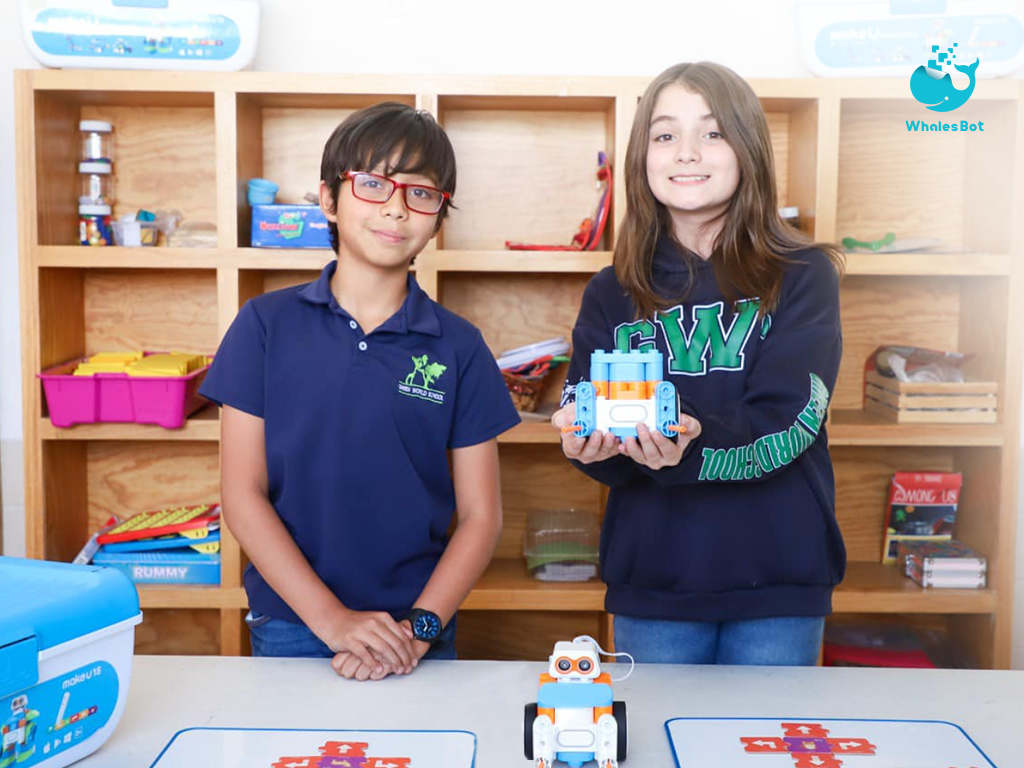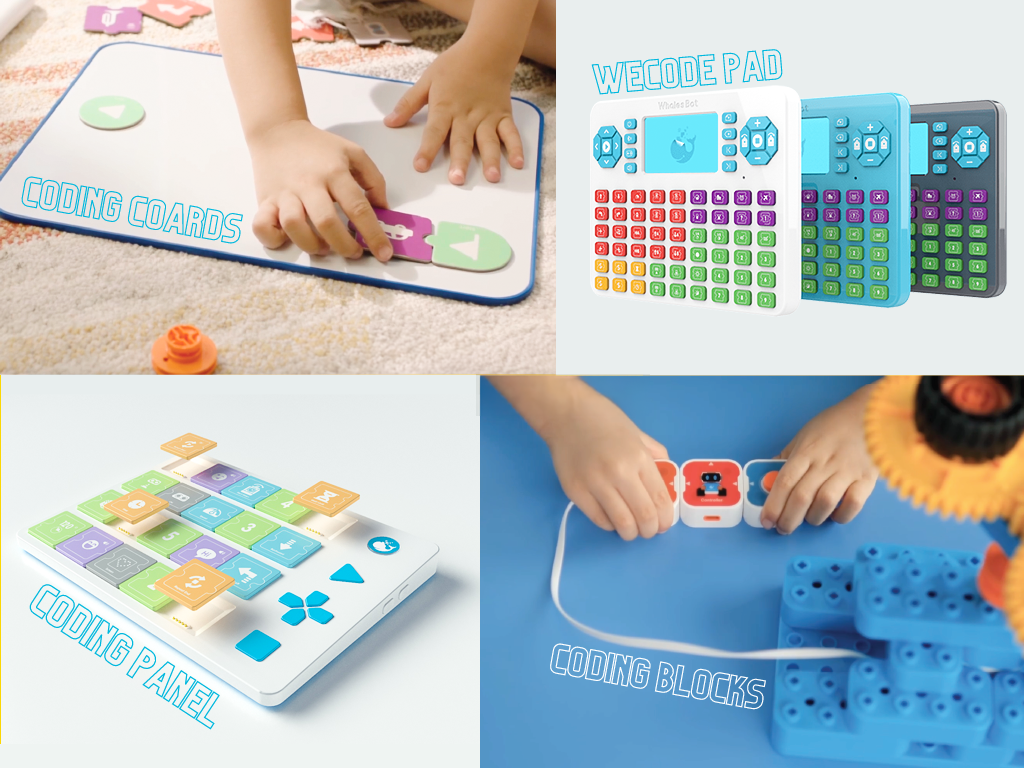As technology continues to advance at an unprecedented rate, the importance of programming for robotics, often referred to as coding robotics, has become increasingly apparent. But what exactly does it mean to delve into the world of coding robotics, especially for beginners? In this comprehensive guide, we'll explore the fundamentals of programming for robotics that WhalesBot coding robot offers and how it can be an engaging and educational journey for individuals of all ages.
Programming for robotics involves the creation of instructions that enable robots to perform specific tasks autonomously or with human guidance. It combines elements of coding, problem-solving skills, creativity, and critical thinking to bring robots to life and make them functional in various contexts. Whether you're a parent looking to introduce your child to STEM education or an educator seeking innovative ways to engage students, understanding the basics of coding robotics is essential in today's technologically driven world.
What skills can children develop through coding robotics?
Coding robotics offer a multifaceted approach to learning, fostering the development of a wide range of skills beyond just coding itself. Through hands-on experimentation with WhalesBot coding robots, children hone their creativity as they design and build robotic creations with bricks. They also develop critical thinking skills as they debug programs and troubleshoot errors, learning to approach problems systematically and analytically. Additionally, coding robotics encourage collaboration and communication as children work together to tackle challenges and share their ideas with peers.
Furthermore, coding robotics provide an engaging platform for integrating STEM concepts into real-world contexts. By programming WhalesBot code robot to navigate mazes, complete challenges, or interact with its environment, children gain a deeper understanding of science, technology, engineering, and mathematics principles. This holistic approach to STEM learning not only makes abstract concepts more tangible but also sparks curiosity and a passion for exploration.
Getting started with coding robotics: A beginner's guide
Understanding the basics: "Coding blocks and Building blocks"
On the journey of coding robotics, beginners often encounter two fundamental components which are coding blocks and building blocks. These foundational elements serve as the building blocks of robotic programming, providing a tangible and intuitive way for learners to interact with and control their robots. But what's the difference between coding blocks and building blocks?
- Coding blocks: Coding blocks, also known as code blocks or code cards, are physical or virtual blocks that represent programming commands or instructions. Each block corresponds to a specific action or function, such as moving forward, turning left, or activating a sensor. By arranging these blocks in a sequence, users can create programs that dictate the behavior of their robot.
- Building blocks: In addition to coding blocks, building blocks play a crucial role in constructing the physical structure of the robot itself. These blocks, typically made of durable plastic or similar materials, come in various shapes and sizes, allowing users to assemble their robot in a customizable manner.
- WhalesBot coding robots often feature building blocks that are compatible with standard construction toy systems, such as LEGO® bricks. This compatibility not only enhances the versatility of the robot but also encourages creativity and exploration as users design and assemble their robotic creations.
By combining coding blocks with building blocks, beginners can unleash their creativity and embark on exciting coding adventures with their WhalesBot robot. Whether they're programming their robot to navigate obstacle courses, solve puzzles, or interact with its environment, the possibilities for learning and exploration are endless. With a solid understanding of these basic concepts, beginners can confidently dive into the world of coding robotics and unleash their potential as future innovators and problem solvers.
The benefits of robotics kits for STEM learning
A. How robotics kits engage children in STEM activities
Robotics kits, such as WhalesBot code robot, offer a hands-on approach to STEM education that actively engages children in meaningful learning experiences. These kits provide a dynamic platform for children to explore science, technology, engineering, and mathematics concepts in a fun and interactive way.
One of the key ways in which robotics kits engage children in STEM activities is through experiential learning. By building and programming their robots, children are actively involved in the learning process, gaining practical experience and developing a deeper understanding of STEM principles. Whether they're constructing a robot from scratch or customizing pre-designed models, children are encouraged to think critically, problem-solve, and apply their knowledge in real-world contexts.
B. Encouraging creativity and critical thinking skills
One of the greatest benefits of robotics kits, especially WhalesBot code robot, is their ability to encourage creativity and critical thinking skills in children. Through hands-on exploration and experimentation, children are empowered to unleash their imagination and design unique robotic creations.
Robotics kits also challenge children to think critically and problem-solve as they encounter obstacles and setbacks during the design and programming process. From troubleshooting technical issues to optimizing robot performance, children learn to approach problems systematically, analyze solutions, and iterate until they achieve success. This iterative problem-solving approach not only strengthens their critical thinking skills but also builds resilience and perseverance in the face of challenges.
C. Addressing safety concerns with educational robotics toys
Safety is a top priority when it comes to educational toys for children, and robotics kits are no exception. WhalesBot robotics kits are designed with safety in mind, incorporating features that ensure a safe and enjoyable learning experience for children.
The primary safety considerations in robotics kits is the design of the physical components. WhalesBot robotics kits feature durable, non-toxic materials that are safe for children to handle and manipulate. Components are carefully selected to minimize potential hazards, such as sharp edges or small parts that could pose choking hazards.
WhalesBot coding robot promoting safe play,designed to be age-appropriate with features and functionalities that are suitable for children of different ages and skill levels. Clear instructions and guidance are provided to help children safely assemble and program their robots, while built-in safety features ensure that children can experiment and explore without risk of injury. Parents and educators are encouraged to actively engage with children as they explore robotics concepts, providing guidance and support to ensure a safe and enriching learning environment.
Incorporating Coding and Robotics into the Classroom
A. The role of educators in STEM education
Educators play a crucial role in fostering STEM education and cultivating a love for learning in students. As advocates for innovation and exploration, educators have the power to inspire the next generation of scientists, engineers, and innovators through hands-on experiences with coding and robotics.
In the classroom, educators serve as facilitators of learning, guiding students through the process of discovery and exploration. By incorporating coding and robotics into the curriculum, educators can provide students with opportunities to develop essential 21st-century skills, such as problem-solving, critical thinking, and collaboration.
B. Integrating coding skills into preschool curriculum
Early childhood education sets the foundation for lifelong learning, and integrating coding skills into the preschool curriculum can help children develop essential cognitive and social-emotional skills from a young age. Coding activities tailored for preschoolers, such as those offered by WhalesBot code robot, focus on building foundational skills through freedom to express their creativity and problem-solving through play-based learning experiences.
By introducing coding activities in preschool lay the groundwork for future STEM learning by fostering a positive attitude towards technology and inquiry-based learning. By introducing concepts such as cause and effect, logic, and sequencing in a fun and engaging way, educators can ignite a passion for learning and discovery that will stay with children throughout their educational journey.
C. Creating STEM challenges and activities
STEM challenges and activities provide hands-on opportunities for students to apply their coding and robotics skills in real-world contexts. These activities encourage creativity, collaboration, and problem-solving as students work together to design, build, and program solutions to complex problems.
Educators can create STEM challenges and activities that align with curricular objectives and standards, integrating coding and robotics across multiple subject areas. For example, students may design and build a robotic rover to explore planetary surfaces in science class, or program a robotic arm to perform tasks in a simulated manufacturing environment in technology class.
STEM challenges and activities can be tailored to different age groups and skill levels, allowing educators to differentiate instruction and meet the diverse needs of their students. By providing hands-on, experiential learning opportunities, STEM challenges and activities engage students in authentic learning experiences that foster curiosity, creativity, and a deeper understanding of STEM concepts, by incorporating coding and robotics into the classroom through STEM challenges and activities empowers students to become active learners and problem solvers, preparing them for success in an increasingly technology-driven world. With the guidance and support of educators, students can develop the skills and confidence they need to thrive in the 21st century.
Exploring WhalesBot products for coding and robotics
WhalesBot offers a diverse range of coding and robotics products designed to inspire creativity, foster STEM learning, and ignite a passion for exploration. From beginners to advanced users, WhalesBot provides robotics kits that cater to a wide range of ages and skill levels, making it accessible and engaging for learners of all backgrounds.
The WhalesBot U10 is perfect for young learners aged 3-4, offering a kid-friendly magnetic learning kit that introduces basic sequential logic through colorful electronic blocks. Meanwhile, the WhalesBot U30 is geared towards children aged 4-6, featuring a handheld programming board and Bluetooth connectivity for more advanced coding experiences.
For older learners aged 6-8, the WhalesBot S30 offers a comprehensive robotics kit with a 32-bit processor, integrated sensors, and intelligent motors for enhanced programming capabilities. Finally, the WhalesBot S40 is designed for advanced users aged 8 and above, boasting a 32-bit Cortex-M4 processor, a 1-inch color display, and multiple input and output interfaces for limitless coding possibilities.
Features and components of each WhalesBot coding robot product:

WhalesBot U10(Make U Series)
in details:
- Kid-friendly magnetic learning kit
- Introduces basic sequential logic
- Colorful electronic blocks with magnetic attraction and enhances understanding of sensors, controllers, and actuators
- Ideal for children aged 3-4
- Features large, rounded edges for safe gripping by young children

WhalesBot U30(Make U Series)
in details:
- Handheld programming board with Bluetooth connectivity
- Total of 72 buttons capable of issuing over 100 commands
- Built-in buzzer for audio feedback
- Ideal for children aged 4-6
- Encourages experimentation and exploration with coding concepts

WhalesBot S30(Smart Series)
in details:
- Comprehensive robotics kit with a 32-bit processor
- Integrated sensors and intelligent motors
- Supports advanced programming and robotics applications
- Suitable for children aged 6-8
- Provides a platform for hands-on STEM learning and exploration

WhalesBot S40(Smart Series)
in details:
- Advanced robotics kit with a 32-bit Cortex-M4 processor
- 1-inch color display for enhanced visualization
- Multiple input and output interfaces for versatile coding options
- Designed for advanced users aged 8 and above
- Offers a wide range of programming and robotics capabilities for aspiring innovators and engineers
With WhalesBot coding robot, learners of all ages or beginners can encounter on an exciting journey of discovery and innovation, exploring the fascinating world of coding and robotics while honing essential STEM skills for the future. Whether you're a beginner or an experienced coder, there's a WhalesBot coding robot that's perfect for you. Coding and robotics offer beginners a gateway to the future, empowering them with the tools and knowledge needed to navigate the complexities of the digital age with confidence and creativity. For beginners, coding and robotics provide a platform for learning essential STEM concepts in a hands-on, engaging manner. Through experimentation and exploration with coding toys and STEM kits, beginners develop critical thinking skills, problem-solving abilities, and computational thinking—the building blocks of success in the 21st century.
Moreover, coding and robotics foster a growth mindset, encouraging beginners to embrace challenges, learn from failures, and persist in the face of adversity. By providing opportunities for hands-on learning and experimentation, coding and robotics instill a sense of curiosity, resilience, and lifelong learning—a valuable foundation for future success in any field. As parents, one of the greatest gifts we can give our children is the gift of learning and exploration. By adding coding toys and STEM kits to our wish lists, we can provide our children with the tools and opportunities they need to thrive in a technology-driven world. Coding toys and STEM kits offer children a fun and engaging way to develop essential skills such as creativity, critical thinking, and problem-solving. These educational toys provide hands-on learning experiences that ignite curiosity, inspire innovation, and foster a love of learning that will last a lifetime.
Adding coding toys and STEM kits to our wish lists is not just about buying toys, it's about investing in our children's future and empowering them to reach their full potential. So let's make coding and robotics a priority in our homes, schools, and communities, and watch as our children soar to new heights of learning and discovery.
Click here to get your WhalesBot beginner robot kits !!!






